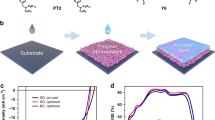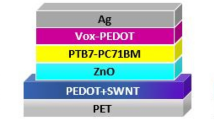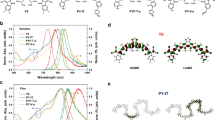Abstract
Efficient and stable organic solar cells via full coating are highly desirable. Poly(3,4-ethylenedioxythiophene):polystyrene sulfonate (PEDOT:PSS) is a classic conducting polymer complex and widely used for hole collection in fully printable devices. However, PEDOT:PSS is typically dispersed in water and exhibits strong acidity that deteriorates device efficiency and stability. Here we report an alcohol-dispersed formulation (denoted as PEDOT:F) by adopting perfluorinated sulfonic acid ionomers as counterions. The ionomers have a special advantage of having two solubility parameters and can be dispersed in water or alcohols, which enables us to prepare PEDOT:F formulations dispersed in alcohols. The alcohol-dispersed formulation has good wetting properties and low acidity, which avoids the drawbacks of aqueous PEDOT:PSS. Fully printable organic photovoltaics (from bottom electrode to top electrode) based on PEDOT:F were obtained with a power conversion efficiency of 15% and could retain 83% of the initial efficiency under continuous illumination at maximum power point tracking for 1,330 h.
This is a preview of subscription content, access via your institution
Access options
Access Nature and 54 other Nature Portfolio journals
Get Nature+, our best-value online-access subscription
$29.99 / 30 days
cancel any time
Subscribe to this journal
Receive 12 digital issues and online access to articles
$119.00 per year
only $9.92 per issue
Buy this article
- Purchase on Springer Link
- Instant access to full article PDF
Prices may be subject to local taxes which are calculated during checkout




Similar content being viewed by others

Data availability
The datasets analysed and generated during the current study are included in the paper and its Supplementary Information. Source data are provided with this paper.
References
Cheng, Y.-B., Pascoe, A., Huang, F. & Peng, Y. Print flexible solar cells. Nature 539, 488–489 (2016).
Hou, J., Inganäs, O., Friend, R. H. & Gao, F. Organic solar cells based on non-fullerene acceptors. Nat. Mater. 17, 119–128 (2018).
Qian, D. et al. Design rules for minimizing voltage losses in high-efficiency organic solar cells. Nat. Mater. 17, 703–709 (2018).
Wang, G., Adil, M. A., Zhang, J. & Wei, Z. Large-area organic solar cells: material requirements, modular designs, and printing methods. Adv. Mater. 31, 1805089 (2019).
Andersen, T. R. et al. Scalable, ambient atmosphere roll-to-roll manufacture of encapsulated large area, flexible organic tandem solar cell modules. Energy Environ. Sci. 7, 2925–2933 (2014).
Li, C. et al. Non-fullerene acceptors with branched side chains and improved molecular packing to exceed 18% efficiency in organic solar cells. Nat. Energy 6, 605–613 (2021).
Zheng, Z. et al. Tandem organic solar cell with 20.2% efficiency. Joule 6, 171–184 (2022).
Meng, L. et al. Organic and solution-processed tandem solar cells with 17.3% efficiency. Science 361, 1094–1098 (2018).
Guo, F. et al. ITO-free and fully solution-processed semitransparent organic solar cells with high Fill factors. Adv. Energy Mater. 3, 1062–1067 (2013).
Carlé, J. E. et al. Overcoming the scaling lag for polymer solar cells. Joule 1, 274–289 (2017).
Czolk, J., Landerer, D., Koppitz, M., Nass, D. & Colsmann, A. Highly efficient, mechanically flexible, semi-transparent organic solar cells doctor Bbaded from non-halogenated solvents. Adv. Mater. Technol. 1, 1600184 (2016).
Eggenhuisen, T. M. et al. High efficiency, fully inkjet printed organic solar cells with freedom of design. J. Mater. Chem. A 3, 7255–7262 (2015).
Strohm, S. et al. P3HT: non-fullerene acceptor based large area, semi-transparent PV modules with power conversion efficiencies of 5%, processed by industrially scalable methods. Energy Environ. Sci. 11, 2225–2234 (2018).
Park, S. et al. Progress in materials, solution processes, and long-term stability for large-area organic photovoltaics. Adv. Mater. 32, 2002217 (2020).
Sun, L. et al. Flexible all-solution-processed organic solar cells with high-performance nonfullerene active layers. Adv. Mater. 32, 1907840 (2020).
Guo, X. & Facchetti, A. The journey of conducting polymers from discovery to application. Nat. Mater. 19, 922–928 (2020).
Jiang, Y., Liu, T. & Zhou, Y. Recent advances of synthesis, properties, film fabrication methods, modifications of poly(3,4-ethylenedioxythiophene), and applications in solution-processed photovoltaics. Adv. Funct. Mater. 30, 2006213 (2020).
Sun, K. et al. Review on application of PEDOTs and PEDOT:PSS in energy conversion and storage devices. J. Mater. Sci.: Mater. Electron. 26, 4438–4462 (2015).
Cameron, J. & Skabara, P. J. The damaging effects of the acidity in PEDOT:PSS on semiconductor device performance and solutions based on non-acidic alternatives. Mater. Horiz. 7, 1759–1772 (2020).
de Jong, M. P., van Ijzendoorn, L. J. & de Voigt, M. J. A. Stability of the interface between indium-tin-oxide and poly(3,4-ethylenedioxythiophene)/poly(styrenesulfonate) in polymer light-emitting diodes. Appl. Phys. Lett. 77, 2255–2257 (2000).
Kim, S., Kim, S. Y., Chung, M. H., Kim, J. & Kim, J. H. A one-step roll-to-roll process of stable AgNW/PEDOT:PSS solution using imidazole as a mild base for highly conductive and transparent films: optimizations and mechanisms. J. Mater. Chem. C. 3, 5859–5868 (2015).
van der Poll, T. S., Love, J. A., Nguyen, T.-Q. & Bazan, G. C. Non-basic high-performance molecules for solution-processed organic solar cells. Adv. Mater. 24, 3646–3649 (2012).
Du, X. et al. Overcoming interfacial losses in solution-processed organic multi-junction solar cells. Adv. Energy Mater. 7, 1601959 (2017).
Mochizuki, Y., Horii, T. & Okuzaki, H. Effect of pH on structure and conductivity of PEDOT/PSS. Trans. Mater. Res. Soc. Japan 37, 307–310 (2012).
Moet, D. J. D., de Bruyn, P. & Blom, P. W. M. High work function transparent middle electrode for organic tandem solar cells. Appl. Phys. Lett. 96, 153504 (2010).
Cheng, P. & Zhan, X. Stability of organic solar cells: challenges and strategies. Chem. Soc. Rev. 45, 2544–2582 (2016).
Adams, J. et al. Water ingress in encapsulated inverted organic solar cells: correlating infrared imaging and photovoltaic performance. Adv. Energy Mater. 5, 1501065 (2015).
Züfle, S. et al. An effective area approach to model lateral degradation in organic solar cells. Adv. Energy Mater. 5, 1500835 (2015).
Nikolka, M. et al. High operational and environmental stability of high-mobility conjugated polymer field-effect transistors through the use of molecular additives. Nat. Mater. 16, 356–362 (2017).
Zuo, G., Linares, M., Upreti, T. & Kemerink, M. General rule for the energy of water-induced traps in organic semiconductors. Nat. Mater. 18, 588–593 (2019).
Maisch, P. et al. A generic surfactant-free approach to overcome wetting limitations and its application to improve inkjet-printed P3HT:non-fullerene acceptor PV. J. Mater. Chem. A 7, 13215–13224 (2019).
Murray-Rust, D. M. & Hartley, H. B. The dissociation of acids in methyl and in ethyl alcohol. Proc. R. Soc. London A 126, 84–106 (1929).
Ferrell, W. H., Kushner, D. I. & Hickner, M. A. Investigation of polymer–solvent interactions in poly(styrene sulfonate) thin films. J. Polym. Sci. B 55, 1365–1372 (2017).
Barton, A. F. M. Solubility parameters. Chem. Rev. 75, 731–753 (1975).
Kusoglu, A. & Weber, A. Z. New insights into perfluorinated sulfonic-acid ionomers. Chem. Rev. 117, 987–1104 (2017).
Hou, X. et al. Improvement of the power conversion efficiency and long term stability of polymer solar cells by incorporation of amphiphilic Nafion doped PEDOT-PSS as a hole extraction layer. J. Mater. Chem. A 3, 18727–18734 (2015).
Lee, T. W., Chung, Y., Kwon, O. & Park, J. J. Self-organized gradient hole injection to improve the performance of polymer electroluminescent devices. Adv. Funct. Mater. 17, 390–396 (2007).
Cho, H. et al. Overcoming the electroluminescence efficiency limitations of perovskite light-emitting diodes. Science 350, 1222–1225 (2015).
Lim, K.-G., Ahn, S., Kim, Y.-H., Qi, Y. & Lee, T.-W. Universal energy level tailoring of self-organized hole extraction layers in organic solar cells and organic–inorganic hybrid perovskite solar cells. Energy Environ. Sci. 9, 932–939 (2016).
Li, W.-L. et al. Perfluorinated ionomer and poly(3,4-ethylenedioxythiophene) colloid as a hole transporting layer for optoelectronic devices. J. Mater. Chem. A 9, 17967–17977 (2021).
Howells, C. T. et al. Influence of perfluorinated ionomer in PEDOT:PSS on the rectification and degradation of organic photovoltaic cells. J. Mater. Chem. A 6, 16012–16028 (2018).
Tang, H., Shang, Y., Zhou, W., Peng, Z. & Ning, Z. Energy level tuning of PEDOT:PSS for high performance tin–lead mixed perovskite solar cells. Sol. RRL 3, 1800256 (2019).
Yeo, R. S. Dual cohesive energy densities of perfluorosulphonic acid (Nafion) membrane. Polymer 21, 432–435 (1980).
Hotchkiss, P. J. et al. The modification of indium tin oxide with phosphonic acids: mechanism of binding, tuning of surface properties, and potential for use in organic electronic applications. Acc. Chem. Res. 45, 337–346 (2012).
Tan, J.-K., Png, R.-Q., Zhao, C. & Ho, P. K. H. Ohmic transition at contacts key to maximizing fill factor and performance of organic solar cells. Nat. Commun. 9, 3269 (2018).
Friedel, B. et al. Effects of layer thickness and annealing of PEDOT:PSS layers in organic photodetectors. Macromolecules 42, 6741–6747 (2009).
Qin, F. et al. Robust metal ion-chelated polymer interfacial layer for ultraflexible non-fullerene organic solar cells. Nat. Commun. 11, 4508 (2020).
Acknowledgements
The work was supported by the National Natural Science Foundation of China (grant numbers 51973074, 51773072 and 61804060) and the special innovation funds of Wuhan National Laboratory for Optoelectronics. The authors would also like to thank the Analytical and Testing Center of Huazhong University of Science and Technology for providing the facilities to conduct characterizations.
Author information
Authors and Affiliations
Contributions
Y.J., X.D. and L.S. contributed equally. Y.J. and Y.Z. conceived the idea and supervised the research. Y.J. designed and synthesized the PEDOT:F. Y.J. and X.D. performed the characterization of PEDOT:F. T.L. and F.Q. measured the work function. C.X. measured the external quantum efficiency. P.J. and L.H. performed fabrication and characterization of MoO3-based cells. Y.J., X.D. and L.S. fabricated and tested the fully printed devices. X.L. tested PEDOT:F in OSCs with a conventional configuration. X.Z. studied the effect of surfactants on the device performance. W.M. tested the PEDOT:F in n–i–p perovskite solar cells. Y.Z., N.L. and C.J.B. coordinated this work. Y.J. wrote the first draft of the manuscript. All the authors revised and approved the manuscript.
Corresponding author
Ethics declarations
Competing interests
The authors declare no competing interests.
Peer review
Peer review information
Nature Energy thanks Ergang Wang and the other, anonymous, reviewer(s) for their contribution to the peer review of this work.
Additional information
Publisher’s note Springer Nature remains neutral with regard to jurisdictional claims in published maps and institutional affiliations.
Supplementary information
Supplementary Information
Supplementary Figs. 1–25, Tables 1–9 and References.
Supplementary Data 1
Source data of Supplementary Fig. 19.
Supplementary Data 2
Source data of Supplementary Fig. 21.
Source data
Source Data Fig. 2
(Fig. 2c) Source data of absorbance spectra of ZnO films with and without PEDOT:F or PEDOT:PSS coating. d, Statistical source data of work function of PEDOT:F films.
Source Data Fig. 3
(Fig. 3b) Statistical source data of PCE of cells with different active layers. c–e, Source data of J–V characteristics of cells with PEDOT:F processed from different conditions and statistical source data of PCE of cells with PEDOT:F processed from different conditions.
Source Data Fig. 4
(Fig. 4b) Source data of J–V characteristics of fully coated solar cells and statistical source data of PCE of fully coated solar cells. c, Source data of PCE evolution as a function of time under illumination of fully coated solar cells. e, Source data of J–V characteristics of fully coated solar modules.
Rights and permissions
About this article
Cite this article
Jiang, Y., Dong, X., Sun, L. et al. An alcohol-dispersed conducting polymer complex for fully printable organic solar cells with improved stability. Nat Energy 7, 352–359 (2022). https://doi.org/10.1038/s41560-022-00997-9
Received:
Accepted:
Published:
Issue Date:
DOI: https://doi.org/10.1038/s41560-022-00997-9
This article is cited by
-
Increase in the efficiency and stability of large-area flexible organic photovoltaic modules via improved electrical contact
Nature Energy (2024)
-
Advantages, challenges and molecular design of different material types used in organic solar cells
Nature Reviews Materials (2023)
-
Lifetime over 10000 hours for organic solar cells with Ir/IrOx electron-transporting layer
Nature Communications (2023)
-
Inkjet-Printed Organic Solar Cells and Perovskite Solar Cells: Progress, Challenges, and Prospect
Chinese Journal of Polymer Science (2023)
-
Efficiency and stability improvement of non-fullerene organic solar cells with binary anode buffer layer
Journal of Materials Science: Materials in Electronics (2023)


